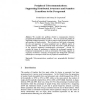Free Online Productivity Tools
i2Speak
i2Symbol
i2OCR
iTex2Img
iWeb2Print
iWeb2Shot
i2Type
iPdf2Split
iPdf2Merge
i2Bopomofo
i2Arabic
i2Style
i2Image
i2PDF
iLatex2Rtf
Sci2ools
ICOST
2007
Springer
2007
Springer
Peripheral Telecommunications: Supporting Distributed Awareness and Seamless Transitions to the Foreground
We consider two problems related to communication between geographically distributed family members. First, we examine the problem of supporting peripheral awareness, in order to improve both emotional well-being and awareness of family activity. This is based on a field study to determine the role and importance of various peripheral cues in different aspects of everyday activities. The results from the study were used to guide the design of our proposed augmented communications environment. Second, we consider the choice of mechanism to facilitate the on-demand transition to foreground communication in such an environment. The design suggests an expansion of Buxton’s taxonomy of foreground and background interaction technologies to encompass a third class of peripheral communications.
| Added | 08 Jun 2010 |
| Updated | 08 Jun 2010 |
| Type | Conference |
| Year | 2007 |
| Where | ICOST |
| Authors | Yosuke Kinoe, Jeremy R. Cooperstock |
Comments (0)

